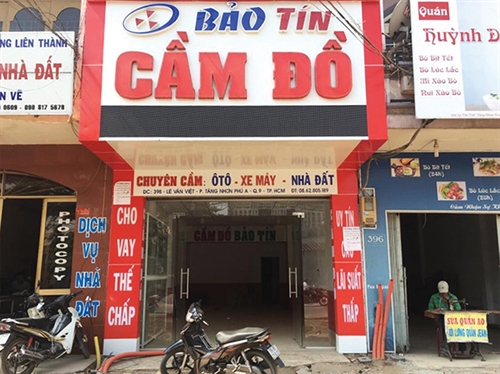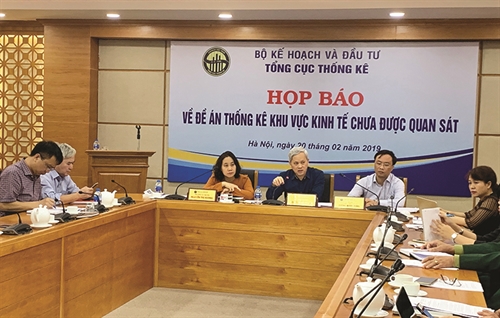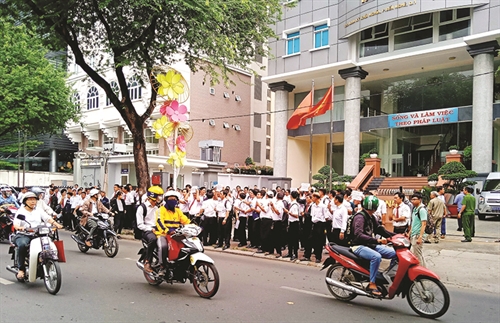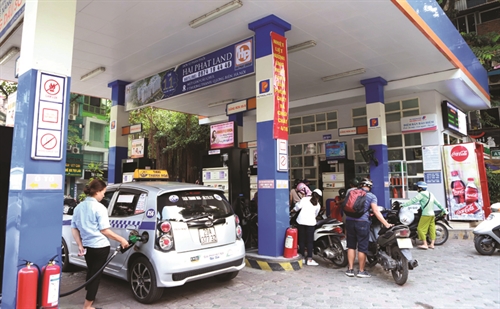In January 2019, local media reported that Le Dinh Huu Phuoc, a 55-year-old man in the Central Highlands province of Gia Lai, was beaten to death by a group of gangsters for failing to fully pay his nephew’s debt.
Phuoc was among thousands of victims of illegal credit, or locally known as “black credit”, all over the country. According to the Ministry of Public Security’s statistics, over the past four years, the police have detected more than 7,600 illegal credit-related criminal cases, including 56 cases of murder, 398 cases of causing injury intentionally, 629 cases of robbery, 836 cases of property seizure, 165 cases of property destruction, and 170 cases of swindling, among others.
 |
| Pawning and day-loan services are popular in almost all localities__Photo: Internet |
Later in March, the police office in the central province of Thanh Hoa announced the result of investigation into a large “black credit” group operating under the cover of a finance company. It was found that the loan shark - Tin Nghia company - offered loans with yearly interest rates ranging between 100 percent and 300 percent. When borrowers are late in paying the interest, they will be threatened, harassed and assaulted.
To cope with the situation, the State Bank Governor on March 18 inked a document, coded 1783/NHNN-TD, requesting local administrations to join hands with the banking sector in the fight against “black credit”. Before discussing measures for tackling “black credit”, let’s examine the nature of this illegal lending practice and the reasons behind its rampant development across the country.
What is “black credit” and why do people fall into its traps?
For the time being, people seemingly mistake “black credit” for usury.
Under Article 468 of the 2015 Civil Code, the interest rate of a loan may be agreed upon by the involved parties but must not exceed 20 percent of the loan amount per year, unless otherwise prescribed by a relevant law. Article 201 of the 2015 Penal Code makes it clear that the threshold for a person to be subject to penal liability for usury is “providing loans in civil transactions at an interest rate five times or more higher than the highest interest rate prescribed in the Civil Code, gaining illicit profit of between VND 30 million (USD 1,300) and under VND 100 million (USD 4,300), or committing the offense although having been administratively sanctioned for this act, or convicted of this offense and not had such conviction expunged.”
Hence, what is the difference between usury and “black credit”?
According to lawyer Tran Minh Hai, director of BASICO law firm, “black credit” should be identified based on not only the interest rate but also its form and consequences.
“There are cases in which borrowers, for their practical benefits, are willing to pay an interest rate much more higher than the law-prescribed one. This is a civil relation. As long as the two parties so agree, it is unreasonable to cite the reason of preventing overcharging to prosecute lenders because it is incompatible with market,” Hai was quoted by the news web VnExpress as saying.
“The grant of a loan will be considered a ‘black credit’ practice if there appear any deceitful or forcible factors or if the lender shows signs of infringing upon the life or health or appropriating property of the borrower,” Hai analyzed.
Loan sharks often offer loans of up to tens of millions of dong which may be disbursed right away without collaterals or with just ID cards or ATM cards as collaterals. However, in case borrowers cannot repay their debts in time, they and their relatives will be subject to scary violent debt collection tricks.
The question here is why people still fall into “black credit” traps despite the fact that local media have once and again given warning information about this illegal lending practice?
The answer is very simple. “Black credit” is too easy to access. Flyers and leaflets advertising payday loans by phone calls can be found everywhere. “Compared to legal credit, ‘black credit’ is currently stronger because it is simply there to meet the demand,” Hai commented on Vietnam Investment Review.
“People always have a demand to borrow money and the most obvious place to go is banks and finance companies. However, current regulations in State Bank Circulars 39 and 43 of 2016 on consumer lending remain barriers to meet this demand,” Hai said.
“These circulars tie the hands of credit companies. For instance, a person borrows money from another person to buy a motorbike, then needs a new loan to repay the first debt. In this case, financial and banking institutions cannot lend money because this demand is not within the tenets of above-said circulars. Meanwhile, ‘black credit’ meets any needs of borrowers, even when the borrowers do not specify the reason. This is the outstanding strength of ‘black credit’ and also the reason why many people seek ‘black credit’,” Hai explained.
Solutions for getting rid of “black credit”
At a recent seminar entitled “Developing consumer credit - Solutions for repelling ‘black credit’”, most economic and banking experts agreed that consumer credit was the most effective tool in the fight against ‘black credit’.
According to the State Bank’s statistics, by the end of 2012, the total outstanding loans of consumer lending were about VND 230 trillion (USD 10 billion), accounting for 8 percent of the economy’s total credit balance. By the end of 2018, the consumer credit balance reached about VND 1.4 quadrillion (USD 60.87 billion), six times as much as in 2012, accounting for about 19.4 percent of total outstanding loans in the economy.
“With a population of more than 95 million, incomes rise along with the economy and so does the demand for loans and access to loans. The consumer credit market has great potential to develop in the future,” said Tran Kim Anh, Deputy Director of the General Economic Department under the Central Economic Commission, at the seminar.
Nguyen Tu Anh, Deputy Director of the State Bank’s Monetary Policy Department, said consumer credit will continue to develop strongly in the coming time due to the rapid growth of the middle class as well as Vietnam’s much-lauded medium-term economic potential.
However, there remain barriers that hinder people’s access to consumer credit, e.g. cumbersome loan appraisal procedures and strict financial capacity requirements.
Wishing to buy a new motorbike, Le Viet Chau, a salaried employee in Ho Chi Minh City’s Tan Binh district, accessed VP Bank’s online lending website vayonline.vpbank.com.vn to apply for a loan of VND 50 million (USD 2,150) in 12 months.
“After completing an online form with around 50 information items about myself and my family members, the website asks me to prove financial capacity and employment by scanning and submitting copies of my ID card, household registration book, house ownership certificate, employment contract or salary promotion decision or salary transfer account’s balance sheet. Then I have to wait for two days for the website to process my information and assess whether I’m qualified for the loan,” Chau told Nguoi Lao Dong.
“However, those whose monthly salary amount is VND 10 million or less and who concurrently owe loans of VND 50 million or more to another bank will be ineligible for unsecured loans,” Chau was informed by the lending website. After considering these rules, Chau found that he could not meet the conditions and decided not to continue applying for the loan.
Nguyen Thanh Phuc, Deputy General Director of FE Credit, suggested that the State Bank should revise current regulations to facilitate operation of consumer finance companies.
“Consumer finance companies do not hesitate to grant a consumer loan of just VND 5 million. However, we have to go through all steps of appraisal like in the case of a bank providing a car loan of VND 500 million. This means that finance companies have to bear bigger management expenses whereas consumer loans are often unsecured ones with high credit risks,” Phuc told Lao Dong, adding that most finance companies’ clients are sub-standard customers who are financially unstable and have no assets for use as collaterals.
“Hence, it is necessary to consider abandoning the regulation requiring borrowers to prove use purposes of loans, thus lessening unnecessary administrative costs and burden… Besides, state authorities should devise measures that enable borrowers to prove their income in a simpler and more effective way,” Phuc said.
According to State Bank Governor Le Minh Hung, the State Bank will soon adopt specific regulations on unsecured lending interest rates and conditions, thus helping commercial banks to develop consumer lending products in order to stamp out “black credit”.- (VLLF)









